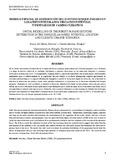| dc.rights.license | http://creativecommons.org/licenses/by-nc-sa/3.0/ve/ | |
| dc.contributor.author | Suárez del Moral, Patricia | |
| dc.contributor.author | Chacón Moreno, Eulogio | |
| dc.date.accessioned | 2012-08-01T16:27:44Z | |
| dc.date.available | 2012-08-01T16:27:44Z | |
| dc.date.issued | 2011-06 | |
| dc.identifier.issn | 1012-1692 | |
| dc.identifier.uri | http://www.saber.ula.ve/handle/123456789/35690 | |
| dc.description.abstract | En los Andes venezolanos la transición de la vegetación hacia el páramo, representada por el bosque paramero, no es uniforme a lo largo del núcleo central de la cordillera, ubicándose a mayores elevaciones en las zonas más húmedas y a menores elevaciones en zonas más secas. Las temperaturas, régimen hídrico, exposición y pendiente son los principales condicionantes ambientales para el establecimiento de la vegetación. En este trabajo se recolectó información climática proveniente de estaciones meteorológicas y se generó información topográfica a partir de un modelo digital de elevación con la finalidad de dilucidar la interacción que pudiese existir entre variables ambientales y variaciones en la ubicación altitudinal del bosque paramero. Partiendo de estos resultados se modeló la ubicación altitudinal del límite bosque-páramo, ubicación que parece señalar que no es el total anual de precipitaciones lo que determina que el límite en zonas secas se encuentre más abajo sino la estacionalidad y contraste entre épocas secas y húmedas. Con el modelo obtenido se evaluó la potencial distribución del bosque paramero ante aumentos de temperatura y disminución de las precipitaciones según proyecciones del IPCC, Se encontró que la disminución del área del bosque paramero pudiera ser de 7% a 36%. | es_VE |
| dc.language.iso | es | es_VE |
| dc.publisher | SABER-ULA | es_VE |
| dc.rights | info:eu-repo/semantics/openAccess | |
| dc.subject | Bioclima | es_VE |
| dc.subject | Bosque preparamero | es_VE |
| dc.subject | Climáticos de Sobre (CEM) | es_VE |
| dc.subject | Modelos | es_VE |
| dc.subject | SIG | es_VE |
| dc.title | Modelo espacial de distribución del ecotono bosque-páramo en Los Andes venezolanos. Ubicación potencial y escenarios de cambio climático | es_VE |
| dc.title.alternative | Spatial modelling of the forest-paramo ecotone distribution in the Venezuelan Andes. Potential location and climatic change scenarios | es_VE |
| dc.type | info:eu-repo/semantics/article | |
| dc.description.abstract1 | In the Venezuelan Andes the transition towards the Páramo, the pre-páramo forest, is not uniform all along the central cordillera and it’s located at higher altitudes in moist areas and lower altitudes in dryer areas. Temperatures, hydrologic regime, exposure and slope are the main variables that determine the establishment of the vegetation. In this work climatic data was collected from meteorological stations and topographic data was generated from digital elevation models (DEM) of the area in order to clarify the interaction that could exist between these environmental variables and the variations in the location of the paramero forest. Out of these results the altitudinal location of the forest-páramo limit was modeled and it suggests that rather than the total amount of precipitation is the seasonality and contrast between dry and moist seasons that determine the lower forest-páramo limit in dry areas. The model was later used to evaluate the potential distribution of the preparamo forest under the effects of temperature increase and lowering of precipitation according to projections made by the IPCC. The result was that the area loss could go from 7% to 36%.of paramero forest. | es_VE |
| dc.description.colacion | 3-25 | es_VE |
| dc.description.email | delmoral@ula.ve | es_VE |
| dc.description.email | eulogio@ula.ve | es_VE |
| dc.description.frecuencia | semestral | |
| dc.identifier.depositolegal | 198802ME173 | |
| dc.publisher.pais | Venezuela | es_VE |
| dc.subject.keywords | Bioclime | es_VE |
| dc.subject.keywords | Climate Envelope Models (CEM) | es_VE |
| dc.subject.keywords | GIS | es_VE |
| dc.subject.keywords | Preparamero forest | es_VE |
| dc.subject.thematiccategory | Biología | es_VE |
| dc.subject.tipo | Revistas | es_VE |
| dc.type.media | Texto | es_VE |


